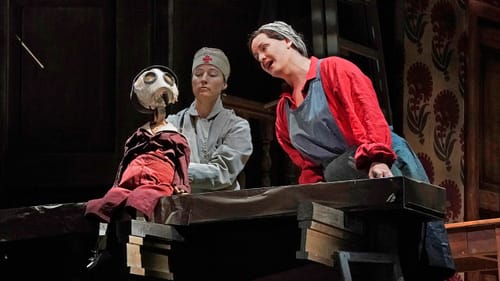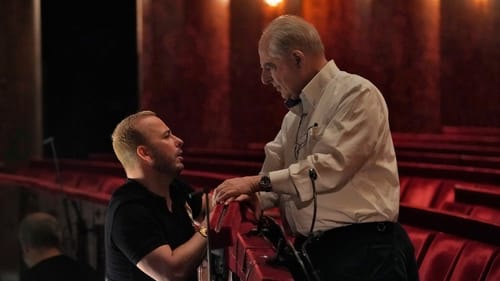Stay in the Loop
BSR publishes on a weekly schedule, with an email newsletter every Wednesday and Thursday morning. There’s no paywall, and subscribing is always free.
Nézet-Séguin makes his mark at the Met
The Metropolitan Opera presents Alban Berg’s ‘Wozzeck’

The Metropolitan Opera took a risk by programming a new production of Wozzeck just two days after Christmas. Alban Berg’s Expressionist masterpiece is a tough sell under any circumstances, but its brutal depiction of poverty, violence, and desperation seems especially ill suited as a cure for the post-holiday doldrums: the last time I saw this work at the Met, in 2014, there were acres of empty rows. So it was gratifying to find so many seats occupied on opening night.
The larger-than-usual audience likely came to witness music director Yannick Nézet-Séguin’s first outing in this difficult score. Now in his second season leading the company, this choice of opera was a risk, and a test.
Succeeding Levine
James Levine, Nézet-Séguin’s disgraced predecessor, virtually owned this work during his 40-year association with the Met. By programming Wozzeck this season, Nézet-Séguin announced his intention to put his own stamp on his forebearer’s repertoire, and to remind the audience that the Met has entered a new era. Boy, did he ever.
In fact, the orchestral forces provided the most unilaterally satisfying element of the performance, with Nézet-Séguin finding every distinct color and mood in Berg’s intricate orchestration. He highlighted individual voices throughout the orchestra—a piccolo here, a harp there—without losing the rich and intricate texture of the musical language as a whole.
The slicing strings seemed to manifest the knife used by Wozzeck to kill his common-law wife, Marie, in the opera’s concluding act. Nézet-Séguin built the tension so skillfully that the act of violence came as a relief—then he left you to question why such a shocking act provoked such a feeling. (I think Berg would approve.) Similarly, the brass shimmered in the concluding orchestral interlude, swelling into an almost oppressively mournful cries. In Berg’s music, and in the story it supports, beauty and terror are inextricably linked. Nézet-Séguin captured that.
A greater distance
The Met’s new production, by South African visual artist William Kentridge, didn’t always elicit the same sense. As he did with his prior productions, of Berg’s Lulu (2015) and Shostakovich’s The Nose (2009), Kentridge used mixed media and abstract stage pictures to amplify the opera’s subtext—here, that the tortured lives of poor Germans are beyond salvaging. The rubble-strewn unit set, by Sabine Theunissen, stood in for every location in the libretto: the army barracks; the local tavern; the hovel that Wozzeck and Marie share; the dark woods where they both meet their end.

It’s visually striking, as are the projections (by Catherine Meyburgh) that evoke drawings by Otto Dix and Egon Schiele, the composer’s contemporaries, as well as the early films of Georges Méliès. But the overreliance on these visual elements—along with a failure to ground the opera’s dramaturgy in a concrete and recognizable world—further distances a work that already keeps its audience at arm’s length.
The starring voices
This could have been mitigated with a more experienced pair of interpreters at the center of the production. Baritone Peter Mattei (Wozzeck) and soprano Elza van den Heever (Marie) are both making their role debuts in these performances, and while they may begin to fully inhabit their characters as the run goes on, neither was there yet on opening night.
Mattei’s sound is more lyrical than one usually hears in the title role. This made the character seem more appealingly meek and mild; unfortunately, it also meant that he wasn’t consistently audible over the large orchestra.
More surprisingly, for an artist who is one of the great recitalists of our time, Mattei didn’t always make the words fully count. Each repetition of Wozzeck’s plaintive refrain, “Wir arme Leut” (We poor people), sounded wan and similar, not infused with the psychic pain it should hold. As Wozzeck drowns while searching the lake for the knife that killed Marie, he exclaims, “Das Wasser ist Blut” (The water is blood). But on Mattei’s lips, it sounded almost casual.
Van Den Heever’s performance also lacked a sense of progression. She seemed neither sufficiently carefree early in the opera, as she flirts with passing soldiers, or anguished near the end, when she begs for God’s forgiveness after being unfaithful to Wozzeck. A major stumbling block for van den Heever may be that she’s asked to play opposite a wooden puppet as her child—not the most present or receptive of scene partners.
Kentridge is not the first director to introduce puppetry as a stand-in for a non-singing character. The late Anthony Minghella did it effectively in his production of Madama Butterfly, also for the Met. But Minghella’s conception drew on the Bunraku tradition, which made conceptual and cultural sense within the context of the work, and the puppeteers have always been exceptionally dramatic whenever I’ve seen that staging. Here, the puppet-child remains largely stationary, a looming figure.

The loudest ovation
The supporting performers offered more nuanced interpretations, though Christopher Ventris’s heldentenor sounded a touch worn as the swaggering Drum Major who seduces Marie. Although Kentridge’s direction casts them both as stock villains in outlandish costumes (designed by Greta Goiris), tenor Gerhard Siegel and bass-baritone Christian Van Horn were vocal and dramatic standouts as the Captain and Doctor who mercilessly torture Wozzeck. Debuting tenor Andrew Staples flaunted a robust, ringing voice in the small role of Andres, Wozzeck’s only friend. Tenor Brenton Ryan was memorable as The Fool.
Wozzeck features one of the most devastating conclusions in all of opera: Wozzeck and Marie’s child, upon hearing of his parents’ deaths, cannot comprehend the loss. He toddles offstage on a hobby horse, blissfully unaware, as the music dissipates. As with so much of Kentridge’s staging, that moment feels anticlimactic.
Still, Nézet-Séguin’s understanding of the score never falls below total mastery—even when the production stalls, he keeps the action hurtling forward. It was appropriate that, at the curtain call, he received the loudest ovation.
What, When, Where
Wozzeck. By Alban Berg. Conducted by Yannick Nézet-Séguin. Production by William Kentridge. Through January 22, 2020, at the Metropolitan Opera, 30 Lincoln Center Plaza, New York, NY. (212) 362-6000 or metopera.org.
A wheelchair-accessible entrance and exit to the opera house is located on the Concourse level, with elevator access to all other seating levels. The Metropolitan Opera offers wheelchair-accessible, removable armrest, and companion seating at all performances. Tickets can be purchased in person, online, or by phone.
Sign up for our newsletter
All of the week's new articles, all in one place. Sign up for the free weekly BSR newsletters, and don't miss a conversation.

 Cameron Kelsall
Cameron Kelsall